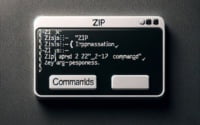Unlocking File Permissions: The ‘chmod’ Linux Command

Are you finding it challenging to change file permissions in Linux? You’re not alone. Many system administrators and developers grapple with this task, but there’s a tool that can make this process a breeze.
Like a master key, the ‘chmod’ command in Linux can unlock different levels of access to your files and directories. This command is a powerful utility that can seamlessly manage your file permissions, providing a versatile and handy tool for various tasks.
In this guide, we’ll walk you through the process of using the chmod command in Linux, from its basic usage to more advanced techniques. We’ll cover everything from understanding file permissions, using chmod to change these permissions, to troubleshooting common issues.
So, let’s dive in and start mastering the chmod command in Linux!
TL;DR: How Do I Use the chmod Command in Linux?
To change file permissions in Linux, you use the
chmodcommand. The command syntax is,chmod [permission_level] [file]changes the permissions of ‘myfile.txt’ to ‘755’. This means the owner can read, write, and execute the file, while others can only read and execute it.
Here’s a simple example:
chmod 755 myfile.txt
ls -l myfile.txt
# Output:
# -rwxr-xr-x 1 user group size date myfile.txt
In this example, we use the chmod command to change the permissions of ‘myfile.txt’ to ‘755’. Then we use the ls -l command to display the file’s permissions. The output -rwxr-xr-x shows that the owner has read (r), write (w), and execute (x) permissions, while the group and others have read and execute permissions.
This is a basic way to use the chmod command in Linux, but there’s much more to learn about managing file permissions. Continue reading for more detailed information and advanced usage scenarios.
Table of Contents
- Understanding the chmod Command: A Beginner’s Guide
- Mastering Advanced chmod Commands
- Exploring Alternative Methods for Changing File Permissions
- Troubleshooting Common chmod Issues
- Linux File Permissions: The Foundation of chmod
- The Impact of chmod in Linux Administration
- Wrapping Up: Mastering the chmod Command in Linux
Understanding the chmod Command: A Beginner’s Guide
The chmod command is a fundamental tool in Linux, used to change the access permissions of files and directories. The name ‘chmod’ stands for ‘change mode’, and it operates on the basis of permission levels.
Chmod Syntax and Basics
The basic syntax of the chmod command is as follows:
chmod [options] mode file
In this syntax:
- ‘chmod’ is the command itself.
- ‘[options]’ are optional parameters that can modify the behavior of the command.
- ‘mode’ is the permission level you want to set. It can be represented either as a numeric value (like 755) or a symbolic value (like u+x).
- ‘file’ is the name of the file or directory you want to modify.
Let’s take a look at an example:
chmod 644 myfile.txt
ls -l myfile.txt
# Output:
# -rw-r--r-- 1 user group size date myfile.txt
In this example, we’re changing the permissions of ‘myfile.txt’ to ‘644’. The ‘644’ mode means the owner has read and write permissions (represented by ‘rw-‘), and the group and others have read-only permissions (represented by ‘r–‘).
Understanding File Permissions
In Linux, each file and directory has three types of permissions: read (r), write (w), and execute (x). Each of these permissions can be granted to three types of users: the owner of the file, the group that owns the file, and others (everyone else).
The chmod command allows us to control these permissions. The numeric mode ‘644’, for instance, translates to read and write permissions for the owner, and read-only permissions for the group and others.
While the chmod command is powerful, it should be used carefully. Incorrectly setting file permissions can lead to potential security risks. For example, granting write access to a sensitive file to all users could allow unauthorized modifications.
Mastering Advanced chmod Commands
As you become more comfortable with the basic chmod command, you’ll find that its true power lies in its advanced features. The chmod command’s flexibility allows it to handle more complex permission management tasks. Let’s explore some of these advanced uses.
Before we dive into the advanced usage of chmod, let’s familiarize ourselves with some of the command-line arguments or flags that can modify the behavior of the chmod command. Here’s a table with some of the most commonly used chmod arguments.
| Argument | Description | Example |
|---|---|---|
-R | Changes files and directories recursively. | chmod -R 755 directory |
-v | Outputs a diagnostic for every file processed. | chmod -v 644 myfile.txt |
-c | Like verbose but report only when a change is made. | chmod -c 644 myfile.txt |
-f | Suppresses most error messages. | chmod -f 644 myfile.txt |
--reference | Sets permissions to match those of the reference file. | chmod --reference=ref_file myfile.txt |
--preserve-root | Fails to operate recursively on ‘/’. | `chmod -R –preserve-root 755 / |
--no-preserve-root | Does not treat ‘/’ specially. | `chmod -R –no-preserve-root 755 / |
Now that we have a basic understanding of chmod command line arguments, let’s dive deeper into the advanced use of chmod.
Using chmod with Different Permission Levels
Chmod can handle different permission levels for the owner, the group, and others. For example, if you want to give read, write, and execute permissions to the owner, and only read and execute permissions to the group and others, you can use the following command:
chmod 755 myfile.txt
ls -l myfile.txt
# Output:
# -rwxr-xr-x 1 user group size date myfile.txt
In the output, ‘-rwxr-xr-x’ shows that the owner has read, write, and execute permissions, while the group and others have read and execute permissions.
Special Permissions with chmod
Chmod also allows you to manage special permissions like setuid, setgid, and sticky bit. For example, to set the setuid permission on a file, you can use the following command:
chmod u+s myfile.txt
ls -l myfile.txt
# Output:
# -rwsr-xr-x 1 user group size date myfile.txt
In the output, ‘-rwsr-xr-x’ shows that the file has the setuid permission (represented by ‘s’ in the owner’s execute field).
Using chmod with Symbolic Permissions
Instead of numeric modes, chmod can also use symbolic permissions. For example, to add execute permission for the owner, you can use the following command:
chmod u+x myfile.txt
ls -l myfile.txt
# Output:
# -rwxr-xr-x 1 user group size date myfile.txt
In the output, ‘-rwxr-xr-x’ shows that the owner now has execute permission.
In all these examples, we’re using the chmod command to manage file permissions in different ways. Remember, understanding and using these advanced features can make your work with Linux file permissions much more efficient and effective.
Exploring Alternative Methods for Changing File Permissions
While the chmod command is a powerful tool for managing file permissions in Linux, it’s not the only one. There are alternative commands that can be used to change file permissions, such as the chown and chgrp commands. These commands provide different approaches to managing file permissions and can be particularly useful in certain scenarios.
Using the chown Command
The chown command is used to change the ownership of a file or directory. This can indirectly affect file permissions, as changing the owner can change who has the owner’s permissions for that file.
Here’s an example of using the chown command:
chown newuser myfile.txt
ls -l myfile.txt
# Output:
# -rw-r--r-- 1 newuser group size date myfile.txt
In this example, we’re changing the owner of ‘myfile.txt’ to ‘newuser’. The ‘ls -l’ command then shows us that the owner of the file has been updated.
Using the chgrp Command
The chgrp command is used to change the group ownership of a file or directory. Like the chown command, this can indirectly affect file permissions by changing who has the group’s permissions for that file.
Here’s an example of using the chgrp command:
chgrp newgroup myfile.txt
ls -l myfile.txt
# Output:
# -rw-r--r-- 1 user newgroup size date myfile.txt
In this example, we’re changing the group of ‘myfile.txt’ to ‘newgroup’. The ‘ls -l’ command then shows us that the group of the file has been updated.
Weighing the Advantages and Disadvantages
While the chown and chgrp commands can be useful, they also have their limitations. They can only change the owner or group of a file, not the specific permissions like chmod can. However, they can be particularly useful when you need to change who has access to a file, rather than what access they have.
In conclusion, while chmod is a powerful command for managing file permissions in Linux, it’s not the only tool at your disposal. By understanding and using commands like chown and chgrp, you can have even more control over your file permissions.
Troubleshooting Common chmod Issues
Even with a strong understanding of the chmod command, you may encounter issues or errors. Let’s discuss some common problems and how to solve them.
Dealing with ‘Permission Denied’ Errors
One of the most common issues you might encounter when using chmod is the ‘Permission denied’ error. This usually happens when you try to change the permissions of a file or directory that you do not own, and you’re not running the command as root.
Consider the following example:
chmod 755 /etc/passwd
# Output:
# chmod: changing permissions of '/etc/passwd': Operation not permitted
In this case, you’re trying to change the permissions of the ‘/etc/passwd’ file, which is owned by root. Since you’re not root, you get a ‘Permission denied’ error.
To solve this issue, you can use the sudo command to run chmod as root:
sudo chmod 755 /etc/passwd
This command will ask for your password, and then it will change the permissions of the ‘/etc/passwd’ file as root, bypassing the ‘Permission denied’ error.
Understanding chmod Error Messages
Sometimes, chmod might return an error message that’s hard to understand. For example, if you try to change the permissions of a file that doesn’t exist, you might get an error like this:
chmod 755 non_existent_file.txt
# Output:
# chmod: cannot access 'non_existent_file.txt': No such file or directory
This error message is telling you that chmod can’t change the permissions of ‘non_existent_file.txt’ because the file doesn’t exist. To solve this issue, you need to make sure that the file you’re trying to change the permissions of actually exists.
Avoiding Common Pitfalls
When using chmod, it’s important to avoid common pitfalls. For example, be careful when using the -R option to change permissions recursively. If used incorrectly, this could change the permissions of more files and directories than you intended, potentially leading to serious issues.
Remember, the power of the chmod command comes with responsibility. Always double-check your commands before running them, especially when running as root or using the -R option.
Linux File Permissions: The Foundation of chmod
To truly master the chmod command, we need to understand the fundamentals of file permissions in Linux. These permissions are the building blocks that chmod manipulates to control access to files and directories.
Understanding Linux File Permissions
In Linux, every file and directory has a set of permissions that control who can read, write, or execute them. These permissions are divided into three types: read (r), write (w), and execute (x). Each type of permission can be granted to three kinds of users: the owner (u), the group (g), and others (o).
Let’s consider a file with the following permissions:
ls -l myfile.txt
# Output:
# -rw-r--r-- 1 user group size date myfile.txt
In this example, ‘-rw-r–r–‘ represents the file’s permissions. The first character ‘-‘ indicates the type of file (a ‘-‘ means it’s a regular file). The next three characters ‘rw-‘ represent the owner’s permissions (read and write). The following three ‘r–‘ represent the group’s permissions (read), and the final three ‘r–‘ represent the permissions for others (read).
Deciphering Permission Levels
Permissions can also be represented numerically, with read (r) being 4, write (w) being 2, and execute (x) being 1. You can add these numbers together to get different levels of permissions. For example, a permission level of 7 (4+2+1) gives read, write, and execute permissions. A level of 6 (4+2) gives read and write permissions, but not execute.
In the chmod command, these permission levels are used to set the permissions for the owner, group, and others. For example, ‘chmod 644 myfile.txt’ sets read and write permissions for the owner (6), and read-only permissions for the group and others (4).
Understanding these fundamentals of file permissions in Linux is key to mastering the chmod command. With this knowledge, you can use chmod to precisely control who can read, write, or execute your files and directories.
The Impact of chmod in Linux Administration
The chmod command is not just a tool; it’s a fundamental part of Linux administration and scripting. Its ability to manage file permissions makes it a crucial component in maintaining system security and functionality.
chmod in System Administration
As a system administrator, understanding and effectively using the chmod command is essential. Whether you’re managing user access, setting up a server, or securing sensitive data, chmod allows you to control who can read, write, or execute your files and directories.
Consider this example where a system administrator restricts access to a sensitive file:
chmod 700 sensitive_file.txt
ls -l sensitive_file.txt
# Output:
# -rwx------ 1 user group size date sensitive_file.txt
In this scenario, the administrator uses chmod to change the permissions of ‘sensitive_file.txt’ to ‘700’, granting full access to the owner but restricting access for everyone else.
chmod in Scripting
When writing scripts in Linux, the chmod command often plays a critical role. For instance, you might need to ensure that your script has execute permissions before it can run.
Take a look at this example:
chmod +x my_script.sh
ls -l my_script.sh
# Output:
# -rwxr-xr-x 1 user group size date my_script.sh
Here, we’re using chmod to add execute permissions to ‘my_script.sh’, allowing it to be run as a script.
Exploring Related Concepts
The chmod command is just one piece of the puzzle. To fully understand file permissions in Linux, you should also explore related concepts like file ownership and file security. For instance, the chown and chgrp commands, which change the owner and group of a file, often go hand-in-hand with chmod.
Further Resources for chmod Mastery
Ready to dive deeper into the world of Linux file permissions and the chmod command? Here are some resources to guide you on your journey:
- GNU Coreutils: chmod invocation: This is the official documentation for the chmod command, providing a comprehensive look at its syntax and options.
- Linux File Permissions Tutorial: This tutorial offers a detailed explanation of Linux file permissions, including how to use chmod.
- The Linux Command Line by William Shotts: This free book covers the basics of using the Linux command line, including a chapter on file permissions and chmod.
Wrapping Up: Mastering the chmod Command in Linux
In this comprehensive guide, we’ve delved into the world of the chmod command in Linux, a fundamental tool for managing file permissions.
We began with the basics, understanding the syntax and usage of the chmod command at a beginner level. We then moved onto more advanced topics, exploring the command’s flexibility in dealing with different permission levels, special permissions, and its usage with symbolic permissions.
Along the way, we tackled common issues you might encounter when using chmod, such as ‘Permission Denied’ errors, providing you with solutions and workarounds for each issue. We also considered alternative approaches to changing file permissions, introducing you to commands like chown and chgrp.
Here’s a quick comparison of the methods we’ve discussed:
| Method | Pros | Cons |
|---|---|---|
| chmod | Robust, flexible, handles different permission levels | May require troubleshooting for permission errors |
| chown | Changes file ownership, indirectly affecting file permissions | Only changes owner, not specific permissions |
| chgrp | Changes group ownership, indirectly affecting file permissions | Only changes group, not specific permissions |
Whether you’re just starting out with the chmod command or looking to deepen your understanding, we hope this guide has provided you with a comprehensive understanding of chmod’s capabilities.
With chmod, you can effectively manage file permissions in Linux, enhancing security and control over your system. Happy coding!


